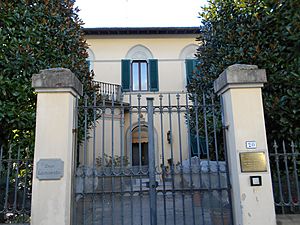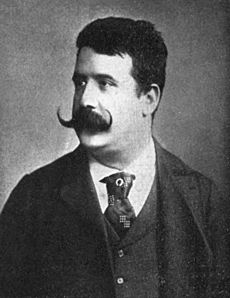Ruggero Leoncavallo facts for kids
Ruggero Leoncavallo (born April 23, 1857 – died August 9, 1919) was a famous Italian opera composer. He also wrote the words for his operas, which are called librettos. Even though he created many operas and songs, he is mostly remembered for his opera Pagliacci (pronounced Pah-lee-AH-chee), which came out in 1892.
Today, Pagliacci is still one of the most popular operas performed around the world. Leoncavallo also wrote the well-known song "Mattinata". This song became very popular thanks to the famous singer Enrico Caruso.
Contents
Life Story of Ruggero Leoncavallo
Ruggero Leoncavallo was born in Naples, Italy, on April 23, 1857. His father, Vincenzo Leoncavallo, was a police magistrate, which is like a judge.
When Ruggero was a child, his family moved to a town called Montalto Uffugo. He spent his teenage years there. Later, he went back to Naples to study music at the San Pietro a Majella Conservatory. He also studied literature at the University of Bologna with a famous Italian poet, Giosuè Carducci.
In 1879, Leoncavallo's uncle, who worked in Egypt, invited him to Cairo. His uncle thought Ruggero could show off his piano skills there. Ruggero found work as a piano teacher and played for the brother of the new ruler, called a Khedive. His time in Egypt ended suddenly in 1882 because of protests. Leoncavallo quickly left for France. In Paris, he found a place to live in a neighborhood called Montmartre.
In Paris, Leoncavallo found a job playing piano and teaching for artists. They performed in Sunday concerts, often in cafés. During this time, he met Berthe Rambaud, who was one of his students. They got married in 1895. Leoncavallo was inspired by French writers and started working on a musical piece called La nuit de mai. He finished it in Paris in 1886. It was first performed in April 1887 and was very successful. With enough money, Leoncavallo and Berthe moved to Milan, Italy. He wanted to start his career as an opera composer there.
Back in Italy, Leoncavallo taught music for a few years. He also tried to get his earlier opera, Chatterton, performed, but it was difficult. In 1890, he saw how successful Pietro Mascagni's opera Cavalleria rusticana was. This opera was in a style called verismo, which means it showed real-life stories. Leoncavallo quickly wrote his own verismo opera, Pagliacci. He said the story for Pagliacci came from a real murder trial his father had overseen.
Pagliacci was performed in Milan in 1892 and was an instant hit! Today, it is the only one of Leoncavallo's operas that is still performed regularly. One of its most famous songs is "Vesti la giubba" ("Put on the costume"). The famous singer Enrico Caruso recorded this song. It was one of the first records ever to sell a million copies.
The next year, his opera I Medici was also performed in Milan. But neither I Medici nor Chatterton (which was finally performed in 1896) became very popular. However, parts of Chatterton were recorded very early, in 1908. Leoncavallo himself either conducted or helped with these recordings.
Leoncavallo's talent was truly confirmed when his opera La bohème was performed in Venice in 1897. However, it was overshadowed by Giacomo Puccini's opera with the same name and story, which came out a year earlier. Still, a few songs from Leoncavallo's La bohème are sometimes performed, especially in Italy.
Other operas by Leoncavallo in the 1900s included Zazà (1900) and Der Roland von Berlin (1904). In 1906, Leoncavallo brought singers and musicians from Italy to perform his music in New York. He also toured the United States. He had another success with Zingari, which premiered in London in 1912.
After writing several operettas (lighter, shorter operas), Leoncavallo tried one last serious opera called Edipo re. It was thought that he finished the music but not the full orchestra parts. Another composer, Giovanni Pennacchio, completed it. However, some people now believe Leoncavallo might not have written much of it at all.
His Death and What He Left Behind
Leoncavallo passed away in Montecatini Terme, Italy, on August 9, 1919. His funeral was held two days later, with many people attending. This included fellow composers Pietro Mascagni and Giacomo Puccini. He was buried in Florence.
Years after his death, there was a plan to move his body to Brissago, Switzerland. Some believed Leoncavallo wanted to be buried there, but no letter from him ever confirmed this. Leoncavallo was an honorary citizen of Brissago and owned a beautiful summer home there. Even though he once mentioned he wouldn't mind being buried in Brissago, it was not a formal request. Still, the plan to move his remains went ahead. His body and his wife Berthe's body were moved to Switzerland.
The Museo Leoncavallo (Leoncavallo Museum) opened in Brissago in 2002. It has his personal items and original music papers. There are also statues of characters from his operas. Another museum, the Museo Ruggiero Leoncavallo, opened in 2010 in Montalto Uffugo, where he grew up. It also has his manuscripts, personal items, and his own piano.
Today, not many of Leoncavallo's other operas are performed often. But some songs from Zazà and La bohème are still popular.
Leoncavallo also wrote many songs. The most famous is "Mattinata". He wrote it especially for the Gramophone Company, thinking of Enrico Caruso's unique voice. On April 8, 1904, Leoncavallo played the piano while Caruso recorded the song.
Leoncavallo wrote the librettos (the words) for most of his own operas. Many people thought he was one of the best Italian librettists of his time. He also helped write the libretto for Puccini's opera Manon Lescaut.
His Operas
- Pagliacci – First performed on May 21, 1892, in Milan.
- I Medici – First performed on November 9, 1893, in Milan. (This was meant to be the first part of a series that was never finished.)
- Chatterton – First performed on March 10, 1896, in Rome. (This was a changed version of a work he wrote in 1876.)
- La bohème – First performed on May 6, 1897, in Venice.
- Zazà – First performed on November 10, 1900, in Milan.
- Der Roland von Berlin – First performed on December 13, 1904, in Berlin.
- Maïa – First performed on January 15, 1910, in Rome.
- Zingari – First performed on September 16, 1912, in London.
- Mimi Pinson – First performed in 1913, in Palermo. (This was a new version of La bohème.)
- Mameli – First performed on April 27, 1916, in Genoa.
- Edipo re – First performed on December 13, 1920, in Chicago. (This opera was performed after Leoncavallo died. The music for the orchestra was completed, or possibly written, by Giovanni Pennacchio.)
His Operettas
- La jeunesse de Figaro – 1906, United States.
- Malbrouck – First performed on January 19, 1910, in Rome.
- La reginetta delle rose – First performed on June 24, 1912, in Rome.
- Are You There? – First performed on November 1, 1913, in London.
- La candidata – First performed on February 6, 1915, in Rome.
- Prestami tua moglie – First performed on September 2, 1916, in Montecatini. (English title: Lend me your wife.)
- Goffredo Mameli – First performed on April 27, 1916, in Genoa.
- A chi la giarrettiera? – First performed on October 16, 1919, in Rome. (English title: Whose Garter Is This?) Performed after he died.
- Il primo bacio – First performed on April 29, 1923, in Montecatini. Performed after he died.
- La maschera nuda – First performed on June 26, 1925, in Naples. Performed after he died.
Other Musical Works
- La nuit de mai – a symphonic poem (a piece of music that tells a story or describes something) for a tenor singer and orchestra, based on a poem by Alfred de Musset. It was created in Paris in 1886.
- Séraphitus Séraphita – another Symphonic Poem based on a book by Honoré de Balzac. It was performed in Milan in 1894.
See also
 In Spanish: Ruggero Leoncavallo para niños
In Spanish: Ruggero Leoncavallo para niños




